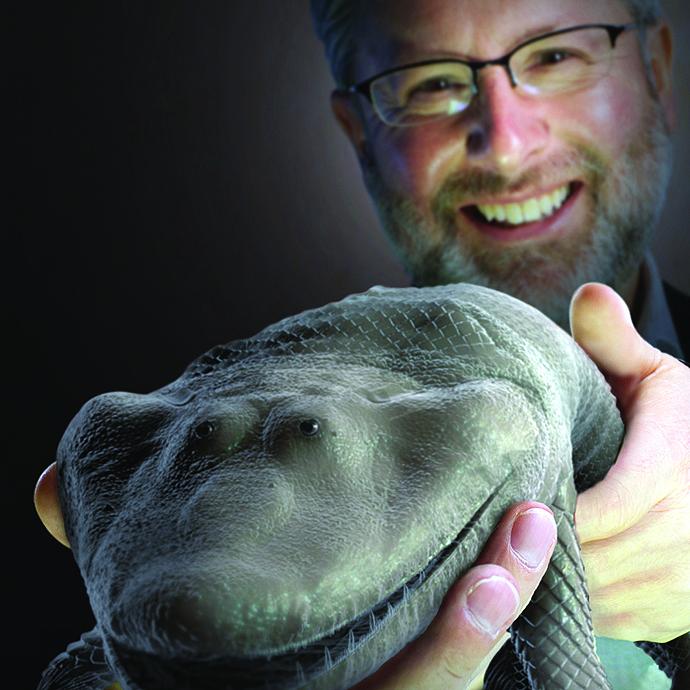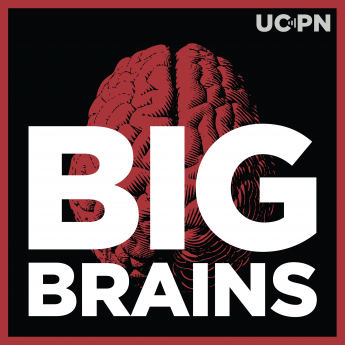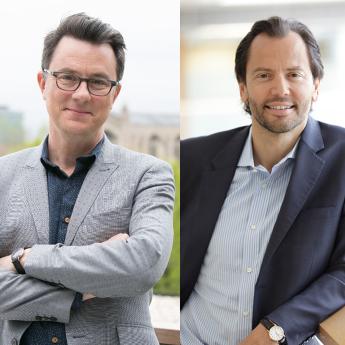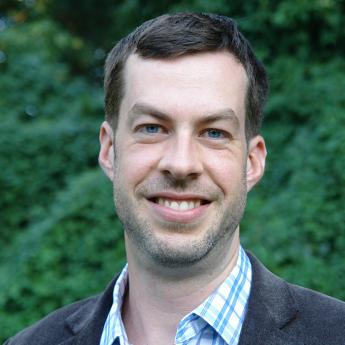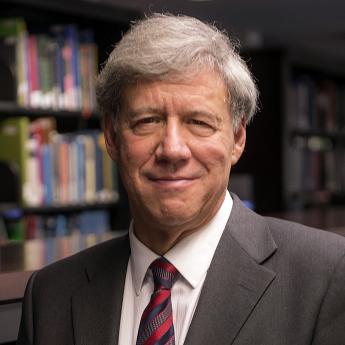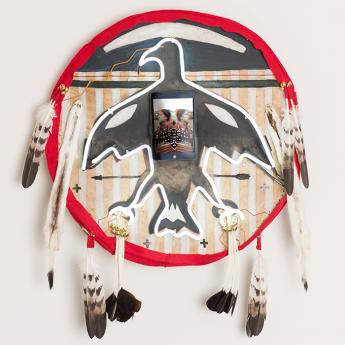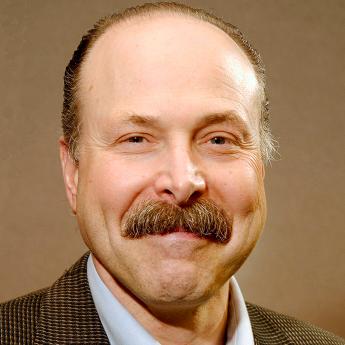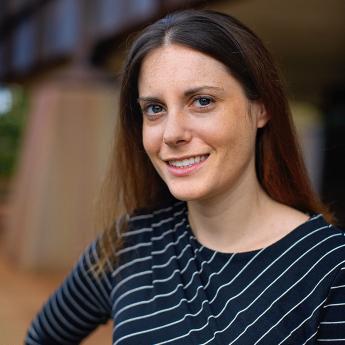Show Notes
University of Chicago evolutionary biologist Neil Shubin said he’ll never forget the day in 2004 when he unearthed the discovery of a lifetime.
After spending six years in the Arctic searching for a fossil that could be a missing link between sea and land animals, Shubin finally found himself eye-to-eye with the 375-million-year-old creature that would come to be known as Tiktaalik roseae.
Transcript:
Producer: From the University of Chicago, this is Big Brains with Paul Rand—conversations with pioneering thinkers that will change the way you see the world.
Paul Rand: The human body is an amazing thing. But did you know that it's an ancient fish you actually have to thank for it. Neil Shubin is a University of Chicago paleontologist and evolutionary biologist. He's the best-selling author of “Your Inner Fish” which is based on his groundbreaking 2006 discovery of Tiktaalik, the three hundred seventy five-million-year-old fossil, that is considered a missing link between fish and humans. I talked with Neil about how he uncovered Tiktaalik in the Arctic Circle after decades of searching and how that breakthrough is continuing to shape our understanding of human evolution. So, Neil you've got quite an extraordinary history and is discovery the right word?
Neil Shubin:Yeah, I'd love to think of it as discovery.
Paul Rand: You know, part of what we try to think about on Big Brains is something that is a pretty monumental insight or discovery that leads to the way people end up seeing the world. And I think of the guests that we have that actually could say, this is really something that really does change the way you're likely to see the world, yours really kind of falls smack in the middle of that doesn't it.
Neil Shubin:Yeah. Well thank you. I mean I'm interested in the big questions of the history of life and you know, why does the world look the way it does. Why do our bodies look the way they do and to that we have to get some really big discoveries but also big issues big ideas?
Paul Rand: Right. So, I wonder if we could just jump right into it and there's quite a story about how you got to but can you just summarize what it is the discovery or the finding that you had and what it actually has led to in terms of thinkings.
Neil Shubin: So, I've been interested pretty much throughout my entire career in the great transitions in the history of life and how the big steps in evolution happen. And the one that I've been settling on for most of my career is the transition from fish to land living animal. And the reason why I see it as a real first-class scientific problem is because you know at first glance it seems so utterly impossible. How did fish evolve to walk and breathe and feed on land? If you break it apart, it just doesn't seem like it could ever happen. But the reality is, as we discover fossils, as we look at genetics and DNA and embryos, that great transition becomes not only possible but highly likely. And then it takes to some great ideas about how inventions happen in evolutionary history. So, it really takes us to the origin of innovation. It takes us to the origin of the modern world. So, discoveries lead us to big ideas.
Paul Rand:Okay. So, the discovery you had was actually a species for lack of a better word you called Tiktaalik.
Neil Shubin:Yeah, that discovery was about seven years in the making. What we wanted to do was find an intermediate between fish and land-living animal. And so, we set off to think about where in the world could we find…
Paul Rand: And this hadn't been done before?
Neil Shubin: People had tried. Yeah, people definitely tried. But the record was getting more precise. So, we hit this field at the right moment. That is, we had a very good idea of where in the world to look for this sort of thing which seems strange. How do you do that? Well what we did was we looked for places in the world that had rocks at the right age to hold a fossil like this. Rocks in the world that had the right kinds of rocks to hold fossils, not every kind of rock does do that. And finally, we needed rocks not only of the right age and the right type but they had to be exposed to the surface. So, with those notions, we looked at the world, looked at maps of the world, geological surveys of the world, and it became very clear that the place that held rocks of the right age type and exposure were in the Canadian Arctic. So, we spent six years looking for this thing. It's not easy. You know, the Arctic is a huge place these fossils are pretty small. So, we had to fumble around for a little bit before we actually located the exact spot. But I'll never forget the day as long as I live. It was July of 2004. We were cracking rocks and we had identified a locality
Paul Rand: And then what's the temperature like as you're up there?
Neil Shubin: A little bit below freezing, and I put it around 20 degrees Fahrenheit. You know that's during the day. But, I mean, it's chilly and windy. Wind is the big thing that gets you. So, we had to learn how to camp and live and lead a small crew up in these situations. There are polar bears up there. I mean you’re not only thinking about fossils, you’re thinking about not getting eaten.
Paul Rand: Right.
Neil Shubin: But we found a site that had lots of fossil bones, and I'll never forget the day as long as I live one of my colleagues cracked a rock from this layer and said, Hey guys what's this? And as soon as I looked at it, I knew we had found the intermediate we've been looking.
Paul Rand: And what was the giveaway?
Neil Shubin: The giveaway was it was a fish, but it was a fish that had a particular kind of flathead which is like early land-living animals. So, I had staring at me the skull of a creature that looked part fish part land living animal. And what made it even better is, as we pulled that skeleton out, we start to see other parts of the body. We started to see its fins and its fins had arm bones and wrist bones inside. We start to see its body, it looked like it had lungs and gills. It had a shoulder that looked like a cross between fish and land-living animal. Here I had a wonderful intermediate between fish and land-living animal found in exactly the right place.
Paul Rand:That's extraordinary
Neil Shubin: Exactly where I predicted. It was a wonderful. It’s funny, were you happy, people sometimes ask us. Yeah, I was happy, but I was just as much relieved as anything else.
Paul Rand: That you found it.
Neil Shubin: Yeah well, it took us six years. I was not doing so great before then.
Paul Rand: Yeah, and so up until now there was an assumption that there was a transition between fish and land animal.
Neil Shubin: Well, we had a very good idea that this transition happened based on other discoveries, we just didn't know the rough details the same way. We had species that had both lungs and gills in the past. We knew that there was a branch of the fish tree of life that was very closely related to us. What we were providing was important details, and it really was some details that tell us about how biological innovation, how biological inventions, happen. When you think of technology, we talk about disruptive innovation, we talked about invention, we talk about how that happens. Well, discoveries like this provide some important insights and that's what this one really did. What it showed us was that many of the features that creatures use to live on land actually originally appeared in fish living in water. Whether it's fingers, whether it's lungs, whether it's arms, the list goes on and on. It's sort of the idea that inventions never happen at the time you think they did. They have many antecedents. So, the idea was that these inventions actually happened in a different setting, and that pre-adapted, pre-setup, these creatures to make the great transition that they did. And that's the big idea here. The big idea is that inventions have long antecedents, and they arise at one point in time for one purpose. But it's usually not the purpose you originally associated with it. And that's really exciting. And you can think about that for so many different features. Feathers, they helped birds fly, while if we look at the fossil record, it turns out feathers didn't originally appear for flight. They appeared in dinosaurs as a kind of ornamentation. Whether it's to pick up mates, or to be received by mates. And so we're seeing this again and again. This is not just an exemplar of the transition from fish land living animal. It's a basic feature of invention in the biological world.
Paul Rand:But is the assumption, as you talk about this that up until Tiktaalik, there were no creatures that were on land or is this something that showed how they could go, or was there fish and then there was land animals
Neil Shubin: A little of both. So, if you think about what the world looked like pre-Tiktaalik, there were creatures on land, there were plants, there are far forests, there are shrubs, there were invertebrate creatures on land. So, other creatures had inhabited land. First the plants then the invertebrates, kind of insect like creatures. But our distant relatives, creatures with bones and backbones, they were all in water. In fact, their entire history up to that point was in water.
Paul Rand: You just used some particular words: our distant relatives. So you mean that in the way it sounded like?
Neil Shubin: Oh I mean it 100 percent. I wrote a book called “Your Inner Fish”. And I wrote “Your Inner Fish” for a reason. Because, if we trace the fossils, if we trace the embryos, if we trace the DNA, our distant history is with other mammals, is with reptiles, with amphibians, with fish, with worms, with all the rest of life on our planet. We are part of an evolutionary tree that contains the rest of life on the planet. We see it in our bodies right. And that's the part of the story here with Tiktaalik that I really love, because when you talk about the origin of a wrist, which you see for the first time in Tiktaalik and it's cousins, when you see the origin of a neck, which you see for the first time in Tiktaalik and it's cousins, you're seeing the origin of parts of her own body.
Paul Rand: That’s extraordinary.
Neil Shubin: It is. And it's extraordinary because we know it from evidence. We know it from data. I can trace the fossils to show how our wrist is related to the wrist of these fish. I could trace the fossils to show how our neck is related to the neck of these fish you know. So, every time you bend your wrists, every time you shake your head, you can thank these fish living in streams three hundred seventy-five million years ago. And it shows how our bodies contain layer after layer of history, and that history is so important to understand why we look the way we do, because it doesn't always make sense why we look the way we do, but history explains so much.
Paul Rand: This idea that we are descendants of fish, or fish like creatures, I imagine created a bit of a stir.
Neil Shubin:Yeah, I mean, I think people are used…it’s the funny stories, you know, if people have a challenge thinking we're related to monkeys, wait till they get a load of the fish. And what I love is to tell the story because when you say your inner fish or when you say you were related to fish, it seems so utterly absurd at one level. Right. I mean come on. But the reality is when you look at the DNA, and the DNA we share with fish, when you look at the fossils and you lay them out and connect us to fish, you start to see that not only is that true but how much of ourselves that explains.
Paul Rand:So all of these discoveries and evolutions are fascinating on so many levels. And when you sit down and think of the significance that this discovery actually means among all the things that it can mean, what has been the most compelling thing that made you really stop and say this is just quite extraordinary.
Neil Shubin:Yeah it's just to show how our world has developed, how history is really important for understanding our world, our present place in the world. That is, so much of our bodies, so much of the ecosystem we live on, and depend, so much of our future in the technologies that are just dictating our future, really it comes down to understanding history very much to begin to see how that all fits together. So, let me break that down a little bit. You know, when you think about the making of our body and why it looks the way it does, history is important whether it's understanding DNA or fossils, but also if you think about what biomedical science does today evolution. Evolutionary history, the kinds of ideas we're talking about, become paramount.
Think about it this way: who have Nobel Prizes in medicine and physiology gone to in last thirty five years. They've gone to people working on flies. They've gone to people working on corn. They've gone to people working on mice. Two Nobel prizes in the last 11 years have gone to five people working on a little tiny worm the size of a comma on a piece of paper. And that worm is telling us on how our genes are turned off in health and disease, how cells are programmed to die and what goes wrong in diseases like cancer. When you think about understanding the cures to what ails us from Alzheimer's and different cancers, understanding our connection to the rest of life on the planet becomes important. How are we similar and different from mice? How are we similar and different from that worm? How are we similar and different from the fly? When you think about fish, right here on the campus of the University of Chicago, fish are being used as models to understand diabetes, Parkinson's, sleep disorder.
Paul Rand: Fish are?
Neil Shubin: Fish. And the reason why is because we have a connection to them, because you can see it in the DNA, and they become model systems experimentally to do things that we could never do on humans. For instance, we can we can really understand their biology and probe it, experimentally, in ways that we would never do in a human.
Paul Rand:So we would normally think of that you're going to have rats or mice or other things but normally you don't think about fish being used in a lab.
Neil Shubin: Yeah. And there are fabulous models for…
Paul Rand: Any type of particular…
Neil Shubin: Yeah there's a fish that's most commonly in laboratories now, actually for the last two decades it's been just increasing in its importance, it's called the zebrafish. The zebrafish is a tiny little fish. We have five labs here on campus that work on it. One lab works on it to model heart disorders in humans. Another to look at diabetes, others to look at skeleton and its formation. Mine uses zebrafish as well. It's a wonderful model because they breed very rapidly. You can get lots of embryos that develop very quickly. You can see through their embryos really beautifully. You can manipulate their genes, you can turn them on and off using certain molecular tools. There's a whole grab bag of techniques you can use to understand them. So, people are working on their inner fish every day in DNA labs to understand clinical situations in humans. And I think that's beautiful. People doing it with flies right, Drosophila. When you think about the fruit fly, Drosophila. So much of what we know about genetics, chromosomes, came out of that.
Paul Rand: You mentioned a few moments ago our futures. And so, if we look back at where we've been, we look at what we're studying right now. What does that tell you or give you some insight into what our futures as human beings could end up looking like.
Neil Shubin:Yeah, I think that a lot. When you think about where we've been—three and half billion years of evolution, that's where we've been. That's where our branch of the tree of life has been, one way or the other. It's really been natural selection, climate change, evolving populations over time. It's been Darwinian evolution. Will the future be Darwinian? Open question. There are certain things that have changed the game for us as a species. One is we developed tools, we have culture, we've education, we share knowledge with each other. So, it's not like the information is going from generation to generation in DNA. In humans that information goes from generation to generation in DNA but importantly it's also shared among people. We're living, we share ideas, we share culture, technology and those can affect human performance.
So I like to think if you and I were to take a time machine and come back to Earth twenty thousand years from now. Get out of the time machine, we look around and we ask a question you know, what are people looking like and how are they doing, what’s their performance? I would think a lot of human performance won't necessarily be based on Darwinian evolution. It would be based more on human technology, inventions, you know we're a species that makes inventions that change the world—for better or for worse. And when you think about human performance whether it's cognitive performance, lifespan, the ability to run, or ride a bicycle really fast. You think about pharmaceuticals and technologies, ideas, social practices, all those things will affect human performance. And so it's hard not to think that those things will be the main drivers of not only what we can do as a species but what the differences among us might be.
Paul Rand: So does this give you a sense, if any sense, of optimism, pessimism, anything else as you think through where we start going from here.
Neil Shubin:I'm a realistic optimists. I think our powers to solve problems grow ever greater. We make bigger problems for ourselves over time, but I think what gets lost in the world is the transformative power of ideas to make human lives better. And I think that's been a driving theme. It's not a unidirectional. There are big blips certainly. And we create our own problems, certainly, and the problems we create become ever more dangerous, certainly. But I'm an optimist. It's hard not to be to look to see what we can do. I mean look at it this way, the last decade has seen the origin of technology, gene sequencing technologies, computer computational technologies, gene editing technologies, technologies that take us to look at human immune systems in certain ways that diseases that were once thought to be incurable, we're beginning to see the possibility they can either be turned into chronic conditions or indeed be cured. You know we're at the cusp of some great stuff in biomedicine, and so it's hard not to be incredibly excited when you look to see what's going on. Just take some of these technologies that are changing the game.
Paul Rand: Now you don't talk when you're talking like this like how you normally think a paleontologist would be talking. How did you be able to take such a much more broader world view?
Neil Shubin: Throughout my entire career, the most important thing to me as a scientist as an intellectual is the question not the technology not the technique. So, my career has been dominated by thinking about the great questions. And then I would reach out to find what are the best tools to answer those questions. So, you know, we talked about the question—great transformations in the history of life—well I trained, originally, as a paleontologist. That's a great tool. I mean we could find an intermediate fossil and dig it out and look at it and and understand what it tells us about the transitions. But there are other tools that are powerful in their own ways to: DNA, embryos, anatomy, all these things. So, if what drives you is the question and you're really athletic about thinking about pulling in the technologies that can answer that question or those questions then obviously you find yourself in the in at the intersection all kinds of great science.
Paul Rand:Do you have a label for what you do right now.
Neil Shubin: I'm an evolutionary biologist evolutionary biologist and I think paleontology is a very big part of my approach, but you know so as those molecular biology, so is anatomy.
Paul Rand:And speaking of that, you've actually taught anatomy to medical students.
Neil Shubin: Yeah, I was really privileged to teach anatomy here in Chicago. So, I came to Chicago in 2000. I came as chairman of the anatomy department which is in the medical school. And as soon as I arrived we had a wave of retirements, and unfortunately those retirements where some of our best teachers in the department who taught the gross anatomy course, you know, the famous first year dissect a cadaver, memorize thousands of new names, highly stressful. They had retired. And here I am leading the department thinking, well I'm gonna have to go in there and teach it myself. So I became the course director. You know, I was always like one step ahead of the students maybe one lecture. But it was really a remarkable experience for me because I got to see another way of looking at the body right. I'm used to thinking of it as an evolution, how it came about over history, but clinicians look at the body as a working machine: what happens when it breaks apart. And they're two very complementary ways of thinking about the body and its workings. But importantly it also gave me a perspective to think about a narrative to describe what I do. And that came about in the first weeks of the course. You know, you hang out with the students at the tables with them dissecting a cadaver and they'd almost invariably say you know Dr. Shubin what kind of doctor are you?
Neil Shubin: Areyou a neurosurgeon or a cardiologist and I’m like, no, I'm a fish paleontologist. You know, what we want our money back. Anyway, but it soon became clear that being a paleontologist and not just any paleontologist, a fish paleontologist, was a very powerful way to teach the basics of human anatomy because many of the basic structures we have are in simpler forms in fish, sharks. So, I use that in teaching, in fact many people now have used it in teaching and that became that's kind of where the idea for the book “Your Inner Fish” and the TV show began was really in the medical anatomy lab. Saying why are fish relevant to people, and it becomes very clear they're incredibly relevant. You think about the wiring of our head and how our ears and jaws and work all the stuff that you would never think of otherwise. And when you break it down it's kind of mind-blowing.
Paul Rand: So let me ask you, all things considering you're still a pretty relatively young man and you.
Neil Shubin: Thank you so much.
Paul Rand: You’re welcome, and you've had some things that careers could be started and finished with and be extraordinarily not only satisfied but incredibly noteworthy. What do you do next. Where do you look back and say, what I still with all the time I have left hopefully this is what I would really love to make sure that I'm putting my energy into.
Neil Shubin:You know, where I feel most alive as a scientist is to be at the cusp of discovery. My heart races, I mean all scientist would say the same thing, the heart just races. And for me a lot of that happens in the field. I'm leading a National Science Foundation grant from the U.S. Antarctic Program. So, we've shifted from the North Pole to the South Pole. We're looking at rocks that are significantly older than the ones that produce Tiktaalik. We’re looking at the deepest deeper branches of the fish evolutionary tree. I led an expedition there last year, we’re going to go back next year. So, we're back in the field. One of the things about being a scientist is there's no lack of problems, there's no lack of questions. You’re always refreshed, and kept humble by the enormity of the questions that lie in front of you as a scientist. And so that's what keeps it exciting. You know, I mean Antarctica is a whole different gig than the north in many ways. We're at a really fun part of the expeditions. For me, the most fun part is when you're in those early phases and trying to figure out, okay where is it going to be. We turned a corner last season. So, we go back next year and hopefully turn another corner on that one. I have a lab that's doing quite a bit with molecular biology. We're looking at the deeper branch the tree. Where did fish come from. How did they get to worms. How they come from worms. You know there's so many lessons to learn and it's just the questions are never ending and the life of discovery is a life of surprises right. And then and it can be very humbling because, you know, sometimes you discover something and you realize you were completely wrong, you know. And that's never fun, but it keeps him mentally fresh. And if you know how to deal with it can be humbling. I mean like a couple of years ago, we were working on the DNA that builds fingers and toes in humans. Turns out that DNA builds the fin rays in fish which is something if you would have told me when I was a graduate student, I’d say that's completely impossible because they're different kinds of bonds. But that's exactly what we've seen it's incontrovertible. So now that's totally shifted my thinking we've moved it in a very different direction because of that.
Paul Rand:So we'll have you back in another episode a few years down the road here. We're going to hear what next levels of big discoveries have come up with but you really lived up to this idea of helping us think through things differently and actually change the way us and all of our listeners are listening. So, it's been wonderful having you as a guest. Thanks for staying with us today.
Neil Shubin:Thanks for having me.
Episode List
What Remains Unanswered After The 2020 Election, with William Howell and Luigi Zingales (Ep. 58)
UChicago economist and political scientist discuss the polls, what lies ahead for Biden and the country post-Trump
When Governments Share Their Secrets—And When They Don't, with Austin Carson (Ep. 57)
Scholar discusses the political theater of foreign policy—and the case for declassifying intelligence
How We Can Fix a Fractured Supreme Court, with Geoffrey Stone (Ep. 56)
Legal scholar examines how nomination of Amy Coney Barrett could tip an increasingly politicized bench
Correcting History: Native Americans Tell Their Own Stories (Ep. 55)
How scholars helped a Chicago museum rethink its representation of Indigenous peoples
The Future of Voting And The 2020 Election, with Assoc. Prof. Anthony Fowler (Ep. 54)
A leading political scholar discusses voting by mail, mobile voting and why he thinks it should be illegal not to vote.
Why The Quantum Internet Could Change Everything, with David Awschalom (Ep. 53)
A world-renowned scientist explores quantum technology and why the future of quantum may be in Chicago
The Way You Talk—And What It Says About You, with Prof. Katherine Kinzler (Ep. 52)
A leading psychologist explains how speech creates and deepens social biases
From LSD to Ecstasy, How Psychedelics Are Altering Therapy, with Prof. Harriet de Wit (Ep. 51)
A leading scientist explains the medical impacts of psychoactive drugs and the popularity of microdosing
How Can We Achieve Real Police Reform? with Sharon Fairley (Ep. 50)
Legal scholar examines whether civilian oversight, policy changes could increase accountability
Black Lives Matter Protests: Hope for the Future? (Ep. 49)
University of Chicago scholars examine the changing conversation around racial injustice and police reform
